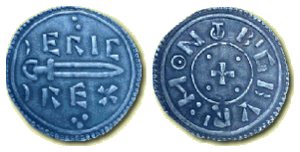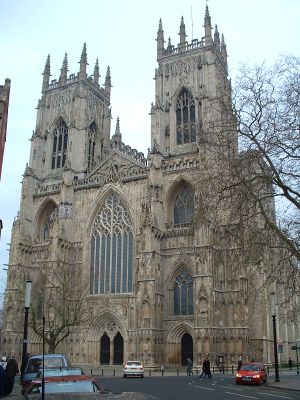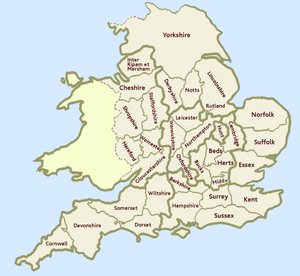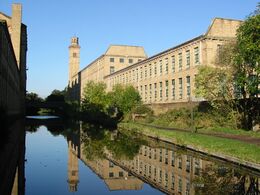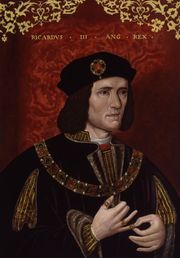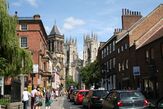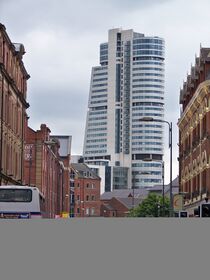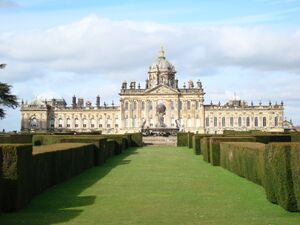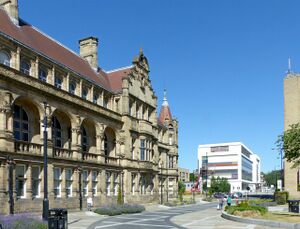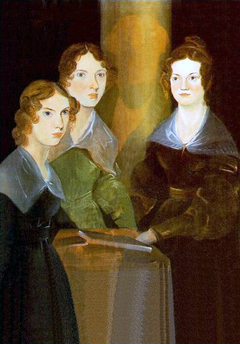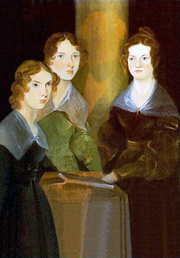يوركشر
| يوركاشير Yorkshire Insular Celtic Eborakon | |
|---|---|
| مقاطعة تاريخية | |
 | |
 موقع يوركشاير في إنگلترة]] يوركشاير في إنگلترة، ويظهر في الخريطة المقاطعات التاريخية | |
| صفة المواطنة | Yorkshire People |
| المساحة | |
| • 1831 | 3,669,510 acres (14,850 km2)[1] |
| • 1901 | 3,883,979 acres (15,718 km2)[1] |
| • 1991 | 2,941,247 acres (11,903 km2)[1] |
| السكان | |
| • 1831 | 1,371,359[1] |
| • 1901 | 3,512,838[1] |
| • 1991 | 3,978,484[1] |
| • 2011 | 5,288,200[2] |
| الكثافة السكانية | |
| • 1831 | 0.37/acre (91/km2) |
| • 1901 | 0.9/acre (220/km2) |
| • 1991 | 1.35/acre (330/km2) |
| التاريخ | |
| الأصل | مملكة جورڤيك |
| التأسيس | في العصور القديمة |
| تبعه | متعددة |
| Chapman code | YKS |
| • المركز الإداري | يورك |
| التقسيمات | |
| النوع | Ridings |
| • الوحدات | 1 North • 2 West • 3 East |
 | |
يوركشاير (Yorkshire، /ˈjɔːkʃə/) هي مقاطعة تاريخية في شمال إنگلترة وأكبر مقاطعات المملكة المتحدة.[3] لكبر مساحتها مقارنة بالمقاطعات الإنگليزية الأخرى، زيدت تقسيماتها الادارية مع مرور الوقت، والتي أصبحت أيضاً تخضع للاصلاح الدوري. نظراً لهذه التغييرات، فلا تزال يوركشاير معترف بها كمنطقة جغرافية واقليم ثقافي.[4][5]
The name is familiar and well understood across the United Kingdom and is in common use in the media and the military,[6] and also features in the titles of current areas of civil administration such as North Yorkshire, South Yorkshire, West Yorkshire and the East Riding of Yorkshire.
Within the borders of the historic county of Yorkshire are large stretches of countryside, including the Yorkshire Dales, North York Moors and Peak District national parks.[7] Yorkshire has been nicknamed "God's Own Country"[8] by its people.[5][9][10]
The emblem of Yorkshire is the White Rose of the English royal House of York, and the most commonly used flag representative of Yorkshire is the white rose on a blue field[11] which, after nearly fifty years of use, was recognised by the Flag Institute on 29 July 2008.[12] Yorkshire Day, held annually on 1 August, is a celebration of the general culture of Yorkshire, ranging from its history to its dialect.[13]
Yorkshire is covered by different Government Office Regions. Most of the county falls within Yorkshire and the Humber while the extreme northern part of the county, such as Middlesbrough, Redcar, Holwick and Startforth, falls within North East England. Small areas in the west of the county are covered by the North West England region.
. . . . . . . . . . . . . . . . . . . . . . . . . . . . . . . . . . . . . . . . . . . . . . . . . . . . . . . . . . . . . . . . . . . . . . . . . . . . . . . . . . . . . . . . . . . . . . . . . . . . . . . . . . . . . . . . . . . . . . . . . . . . . . . . . . . . . . . . . . . . . . . . . . . . . . . . . . . . . . . . . . . . . . . .
التسمية
يتكون اسم مقاطعة يوركشاير من مقطعين، شاير (منطقة ادارية أو مقاطعة)، ومدينة يورك،[14] (local /ˈjɔːk/) أو شاير يورك.[15]
التاريخ
Ancient–500: Hen Ogledd
Early: Celtic Brigantes and Parisi
Early inhabitants of what is now Yorkshire were Hen Ogledd Brythonic Celts (old north British Celts), who formed separate tribes, the Brigantes (known to be in the north and west ridings of now Yorkshire) and the Parisi, East Riding. The Brigantes controlled territory which later became all of Northern England and more territory than most Celtic tribes on the isle of Great Britain. Six of the nine Brigantian poleis described by Claudius Ptolemaeus in the Geographia fall within the historic county.[16][17]
The Parisi, who controlled the area that would become the East Riding of Yorkshire, might have been related to the Parisii of Lutetia Parisiorum, Gaul (known today as Paris, France).[18] Their capital was at Petuaria, close to the Humber Estuary.
43–400s: Britannia Inferior
Although the Roman conquest of Britain began in 43 AD, the Brigantes remained in control of their kingdom as a client state of Rome for an extended period, reigned over by the Brigantian monarchs Cartimandua and her husband Venutius. The capital was between the north and west ridings Isurium Brigantum (near Aldborough) civitas under Roman rule. Initially, this situation suited both the Romans and the Brigantes, who were known as the most militant tribe in Britain.[19]
Queen Cartimandua left her husband Venutius for his armour bearer, Vellocatus, setting off a chain of events which changed control of the region. Cartimandua, due to her good relationship with the Romans, was able to keep control of the kingdom; however, her former husband staged rebellions against her and her Roman allies.[20] At the second attempt, Venutius seized the kingdom, but the Romans, under general Petillius Cerialis, conquered the Brigantes in 71 AD.[21]
The fortified city of Eboracum (now known as York) was named as capital of Britannia Inferior and joint capital of all Roman Britain.[22] The emperor Septimius Severus ruled the Roman Empire from Eboracum for the two years before his death.[23]
Another emperor, Constantius Chlorus, died in Eboracum during a visit in 306 AD. Thereafter his son Constantine the Great, who became renowned for his acceptance of Christianity, was proclaimed emperor in the city.[24] In the early 5th century, the Roman rule ceased with the withdrawal of the last active Roman troops. By this stage, the Western Empire was in intermittent decline.[23]
500s–1000s: Germanic landings
500s–800s: Celtic-Anglo kingdoms of Ebrauc, Elmet, Deira and Northumbria After the Romans left, small Celtic kingdoms arose in the region, including kingdoms of Deira to the east (domain of a settlements near Malton on Derwent), Ebrauc (domain of York) around the north and Elmet to the west. The latter two were successors of land south-west and north-east of the former Brigantia capital.
Angles (hailing from southern Denmark and northern Germany, probably along with Swedish Geats[25]) consolidated (merging Ebrauc) under Deira, York as capital. This was in turn was grouped with Bernicia, another former Celtic-Brigantes kingdom that was north of the River Tees and had come to be headed by Bamburgh, to form Northumbria.[26][27] Elmet had remained independent from the Germanic Angles until some time in the early 7th century, when King Edwin of Northumbria expelled its last king, Certic, and annexed the region to his Deira region. The Celts never went away, but were assimilated. This explains the existence of many Celtic place names in Yorkshire today, such as Kingston upon Hull and Pen-y-ghent.[28]
As well as the Angles and Geats, other settlers included Frisians (thought to have founded Fryston and Frizinghall[29]), Danes, Franks and Huns.[30]
At its greatest extent, Northumbria stretched from the Irish Sea to the North Sea and from Edinburgh down to Hallamshire in the south.[31]
800s–900s: Jórvík
Scandinavian York (also referred to as Jórvík) or Danish/Norwegian York is a term used by historians for the south of Northumbria (modern day Yorkshire) during the period of the late 9th century and first half of the 10th century, when it was dominated by Norse warrior-kings; in particular, used to refer to York, the city controlled by these kings. Norse monarchy controlled varying amounts of Northumbria from 875 to 954, however the area was invaded and conquered for short periods by England between 927 and 954 before eventually being annexed into England in 954. It was closely associated with the much longer-lived Kingdom of Dublin throughout this period.
An army of Danish Vikings, the Great Heathen Army[32] as its enemies often referred to it, invaded Northumbrian territory in 866 AD. The Danes conquered and assumed what is now York and renamed it Jórvík, making it the capital city of a new Danish kingdom under the same name. The area which this kingdom covered included most of Southern Northumbria, roughly equivalent to the borders of Yorkshire extending further West.[33]
The Danes went on to conquer an even larger area of England that afterwards became known as the Danelaw; but whereas most of the Danelaw was still English land, albeit in submission to Viking overlords, it was in the Kingdom of Jórvík that the only truly Viking territory on mainland Britain was ever established. The Kingdom prospered, taking advantage of the vast trading network of the Viking nations, and established commercial ties with the British Isles, North-West Europe, the Mediterranean and the Middle East.[34]
Founded by the Dane Halfdan Ragnarsson in 875,[35] ruled for the great part by Danish kings, and populated by the families and subsequent descendants of Danish Vikings, the leadership of the kingdom nonetheless passed into Norwegian hands during its twilight years.[35] Eric Bloodaxe, an ex-king of Norway who was the last independent Viking king of Jórvík, is a particularly noted figure in history,[36] and his bloodthirsty approach towards leadership may have been at least partly responsible for convincing the Danish inhabitants of the region to accept English sovereignty so readily in the years that followed.
800s–1000s: Yorkshire
After around 100 years of its volatile existence, the Kingdom of Jorvik finally came to an end. The Kingdom of Wessex was now in its ascendancy and established its dominance over the North in general, placing Yorkshire again within Northumbria, which retained a certain amount of autonomy as an almost-independent earldom rather than a separate kingdom. The Wessex Kings of England were reputed to have respected the Norse customs in Yorkshire and left law-making in the hands of the local aristocracy.[37]
. . . . . . . . . . . . . . . . . . . . . . . . . . . . . . . . . . . . . . . . . . . . . . . . . . . . . . . . . . . . . . . . . . . . . . . . . . . . . . . . . . . . . . . . . . . . . . . . . . . . . . . . . . . . . . . . . . . . . . . . . . . . . . . . . . . . . . . . . . . . . . . . . . . . . . . . . . . . . . . . . . . . . . . .
1000s–1400s: Normans
1000s–1100s: Harrying of the north
In the weeks leading up to the Battle of Hastings in 1066 AD, Harold II of England was distracted by pushing back efforts to reinstate the kingdom of Jorvik and Danelaw. His brother Tostig and Harald Hardrada, King of Norway, having won the Battle of Fulford. The King of England marched north where the two armies met at the Battle of Stamford Bridge. Tostig and Hardrada were both killed and their army was defeated decisively.
Harold Godwinson was forced immediately to march his army south, where William the Conqueror was landing. The King was defeated in what is now known as the Battle of Hastings, which led to the Norman conquest of England.
The people of the North rebelled against the Normans in September 1069 AD, enlisting Sweyn II of Denmark. They tried to take back York, but the Normans burnt it before they could.[38] What followed was the Harrying of the North ordered by William. From York to Durham, crops, domestic animals, and farming tools were scorched. Many villages between the towns were burnt and local northerners were indiscriminately murdered.[39] During the winter that followed, families starved to death and thousands of peasants died of cold and hunger. Orderic Vitalis estimated that "more than 100,000" people from the North died from hunger.[40]
In the centuries following, many abbeys and priories were built in Yorkshire. Norman landowners increased their revenues and established new towns such as Barnsley, Doncaster, Hull, Leeds, Scarborough and Sheffield, among others. Of towns founded before the conquest, only Bridlington, Pocklington, and York continued at a prominent level.[41]
In the early 12th century, people of Yorkshire had to contend with the Battle of the Standard at Northallerton with the Scots. Representing the Kingdom of England led by Archbishop Thurstan of York, soldiers from Yorkshire defeated the more numerous Scots.[42]
1300s: Scottish War of Independence and Mass Deaths
The population of Yorkshire boomed until it was hit by the Great Famine of 1315.[41] It did not help that after the English defeat in the Battle of Bannockburn in 1314, the Scottish army rampaged throughout northern England, and Yorkshire was no exception. During The Great Raid of 1322, they raided and pillaged from the suburbs of York, even as far as East Riding and the Humber. Some like Richmond had to bribe the Scots to spare the town. The Black Death then reached Yorkshire by 1349, killing around a third of the population.[41]
1400s–1600s: Royal revolts
1400s: Wars of the Roses
When King Richard II was overthrown in 1399, antagonism between the House of York and the House of Lancaster, both branches of the royal House of Plantagenet, began to emerge. Eventually the two houses fought for the throne of England in a series of civil wars, commonly known as the Wars of the Roses. Some of the battles took place in Yorkshire, such as those at Wakefield and Towton, the latter of which is known as the bloodiest battle ever fought on English soil.[44] Richard III was the last Yorkist king.
Henry Tudor, sympathiser to the House of Lancaster, defeated and killed Richard at the Battle of Bosworth Field. He then became King Henry VII and married Elizabeth of York, daughter of Yorkist Edward IV, ending the wars.[45] The two roses of white and red, emblems of the Houses of York and Lancaster respectively, were combined to form the Tudor Rose of England.[a][46] This rivalry between the royal houses of York and Lancaster has passed into popular culture as a rivalry between the counties of Yorkshire and Lancashire, particularly in sport (for example the Roses Match played in County Cricket), although the House of Lancaster was based in York and the House of York in London.
1500: Catholic-Protestant dissolution The English Reformation began under Henry VIII and the Dissolution of the Monasteries in 1536 led to a popular uprising known as Pilgrimage of Grace, started in Yorkshire as a protest. Some Catholics in Yorkshire continued to practise their religion and those caught were executed during the reign of Elizabeth I. One such person was a York woman named Margaret Clitherow who was later canonised.[47]
1600s: Civil war

During the English Civil War, which started in 1642, Yorkshire had divided loyalties; Hull (full name Kingston upon Hull) famously shut the gates of the city on the king when he came to enter a few months before fighting began, while the North Riding of Yorkshire in particular was strongly royalist.[48][49] York was the base for Royalists, and from there they captured Leeds and Wakefield only to have them recaptured a few months later. The royalists won the Battle of Adwalton Moor meaning they controlled Yorkshire (with the exception of Hull). From their base in Hull the Parliamentarians ("Roundheads") fought back, re-taking Yorkshire town by town, until they won the Battle of Marston Moor and with it control of all of the North of England.[50]
. . . . . . . . . . . . . . . . . . . . . . . . . . . . . . . . . . . . . . . . . . . . . . . . . . . . . . . . . . . . . . . . . . . . . . . . . . . . . . . . . . . . . . . . . . . . . . . . . . . . . . . . . . . . . . . . . . . . . . . . . . . . . . . . . . . . . . . . . . . . . . . . . . . . . . . . . . . . . . . . . . . . . . . .
1500s–1900s: Industry
1500-1600s: Explorative growth
In the 16th and 17th centuries Leeds and other wool-industry-centred towns continued to grow, along with Huddersfield, Hull and Sheffield, while coal mining first came into prominence in the West Riding of Yorkshire.[51] The wool textile industry, which had previously been a cottage industry, centred on the old market towns moved to the West Riding where entrepreneurs were building mills that took advantage of water power gained by harnessing the rivers and streams flowing from the Pennines. The developing textile industry helped Wakefield and Halifax grow.[52]
1800s: Victorian revolution
The 19th century saw Yorkshire's continued growth, with the population growing and the Industrial Revolution continuing with prominent industries in coal, textile and steel (especially in Sheffield, Rotherham and Middlesbrough). However, despite the booming industry, living conditions declined in the industrial towns due to overcrowding. This saw bouts of cholera in both 1832 and 1848.[53] However, advances were made by the end of the century with the introduction of modern sewers and water supplies. Several Yorkshire railway networks were introduced as railways spread across the country to reach remote areas.[54]
As Yorkshire was too large and unwieldy to have its own county council, separate county councils were created for the three ridings in 1889, but their area of control did not include the large towns, which became county boroughs, and included an increasingly large part of the population.[55]
Canals and turnpike roads were introduced in the late 18th century. In the following century the spa towns of Harrogate and Scarborough flourished, due to people believing mineral water had curative properties.[56]
Early 1900s: World wars
During the Second World War, Yorkshire became an important base for RAF Bomber Command and brought the county and its productive industries into the cutting edge of the war, and thus in the targets of Luftwaffe bombers during the Battle of Britain.[57]
1950s–present: Divided
The County Borough of Teesside was created in 1968, drafted by the North Eastern General Review Area from 1962 to 1963 and executed under the Local Government Act 1958, adding settlements to the North Riding's north eastern edges, notably Stockton and Billingham. Twelve in total were placed into a county borough council area. This was the last county borough made and first county to use the local river and '-side' suffix before similar cross river focused counties were created in 1974.[58]
In 1974, they were large local government reforms throughout the United Kingdom. Some of the Local Government Act 1972 changes were unpopular, historic boundaries of Yorkshire and its ridings lost notability status as entities.[59][60]
In 1996, the 'East Riding of Yorkshire' was created from Yorkshire parts of abolished Humberside and North Yorkshire gained Yorkshire parts of Cleveland.[61] The Government Office entity currently containing most of Yorkshire is the Yorkshire and the Humber region of England.[60] This region includes the north-eastern part of Lincolnshire, but not northern parts of Yorkshire, as these areas, located around the River Tees, are in the North East England region. Parts in the North West England region are:
One Yorkshire Devolved Deal proposal
In 2018, eighteen of the twenty-two local councils in the Yorkshire and Humber region voted to elect a mayor to represent the county, including a devolved deal for Yorkshire that would in some regards reunite the county under one deal and mayor. The proposal would allow the mayor similar powers to those possessed by the Mayor of London over Greater London. This would also allow Yorkshire to create up to 200,000 jobs[62][63] across the county and provide similar funding and autonomy to that enjoyed by Greater Manchester.[64]

المكان
الجيولوجيا والأرض
Historically, the northern boundary of Yorkshire was the River Tees, the eastern boundary was the North Sea coast and the southern boundary was the Humber Estuary and Rivers Don and Sheaf. The western boundary meandered along the western slopes of the Pennine Hills to again meet the River Tees.[65] It is bordered by several other historic counties: the county of Durham, Lincolnshire, Nottinghamshire, Derbyshire, Cheshire, Lancashire and Westmorland.[66] In Yorkshire there is a very close relationship between the major topographical areas and the geological period in which they were formed.[65] The Pennine chain of hills in the west is of Carboniferous origin. The central vale is Permo-Triassic. The North York Moors in the north-east of the county are Jurassic in age while the Yorkshire Wolds to the south east are Cretaceous chalk uplands.[65]
Yorkshire is drained by several rivers. In western and central Yorkshire the many rivers empty their waters into the River Ouse which reaches the North Sea via the Humber Estuary.[67] The most northerly of the rivers in the Ouse system is the River Swale, which drains Swaledale before passing through Richmond and meandering across the Vale of Mowbray. Next, draining Wensleydale, is the River Ure, which the Swale joins east of Boroughbridge. Near Great Ouseburn the Ure is joined by the small Ouse Gill Beck, and below the confluence the river is known as the Ouse. The River Nidd rises on the edge of the Yorkshire Dales National Park and flows along Nidderdale before reaching the Vale of York and the Ouse.[67] The River Wharfe, which drains Wharfedale, joins the Ouse upstream of Cawood.[67] The Rivers Aire and Calder are more southerly contributors to the River Ouse and the most southerly Yorkshire tributary is the River Don, which flows northwards to join the main river at Goole. Further north and east the River Derwent rises on the North York Moors, flows south then westwards through the Vale of Pickering then turns south again to drain the eastern part of the Vale of York. It empties into the River Ouse at Barmby on the Marsh.[67]
In the far north of the county the River Tees flows eastwards through Teesdale and empties its waters into the North Sea downstream of Middlesbrough. The smaller River Esk flows from west to east at the northern foot of the North York Moors to reach the sea at Whitby.[67] To the east of the Yorkshire Wolds the River Hull flows southwards to join the Humber Estuary at Kingston upon Hull.
The western Pennines are drained by the River Ribble which flows westwards, eventually reaching the Irish Sea close to Lytham St Annes.[67]
Geography
The countryside of Yorkshire has been called "God's Own County" by its inhabitants.[5][9] Yorkshire includes the North York Moors and Yorkshire Dales National Parks, and part of the Peak District National Park. Nidderdale and the Howardian Hills are designated Areas of Outstanding Natural Beauty,[68] as is the North Pennines (a part of which lies within the county). Spurn Point, Flamborough Head and the coastal North York Moors are designated Heritage Coast areas,[69] and are noted for their scenic views with rugged cliffs[70] such as the jet cliffs at Whitby,[70] the limestone cliffs at Filey and the chalk cliffs at Flamborough Head.[71][72] Moor House – Upper Teesdale, most of which is part of the former North Riding of Yorkshire, is one of England's largest national nature reserves.[73] At High Force on the border with County Durham, the River Tees plunges 22 metres (72 ft) over the Whin Sill (an intrusion of igneous rock). High Force is not, as is sometimes claimed, the highest waterfall in England (Hardraw Force in Wensleydale, also in Yorkshire, has a 30 metres (98 ft) drop for example). However, High Force is unusual in being on a major river and carries a greater volume of water than any higher waterfall in England.[74]

The highest mountains in Yorkshire all lie in the Pennines on the western side of the county, with millstone grit and limestone forming the underlying geology and producing distinctive layered hills. The county top is the remote Mickle Fell[75] (height 788 metres (2,585 ft) above sea level) in the North Pennines southwest of Teesdale, which is also the highest point in the North Riding. The highest point in the West Riding is Whernside (height 736 metres (2,415 ft)) near to Ingleton in the Yorkshire Dales. Together with nearby Ingleborough (height 723 metres (2,372 ft)) and Pen-y-Ghent (height 694 metres (2,277 ft)), Whernside forms a trio of very prominent and popular summits (the Yorkshire Three Peaks) which can be climbed in a challenging single day's walk. The highest point in the Yorkshire part of the Peak District is Black Hill (height 582 metres (1,909 ft)) on the border with historic Cheshire (which also forms the historic county top of that county). The hill ranges along the eastern side of Yorkshire are lower than those of the west. The highest point of the North York Moors is Urra Moor (height 454 metres (1,490 ft)). The highest point of the Yorkshire Wolds, a range of low chalk downlands east of York, is Bishop Wilton Wold (height 246 metres (807 ft)), which is also the highest point of the East Riding. The view from Sutton Bank at the southeastern edge of the North York Moors near Thirsk encompasses a vast expanse of the Yorkshire lowlands with the Pennines forming a backdrop. It was called the "finest view in England" by local author and veterinary surgeon James Herriot in his 1979 guidebook James Herriot's Yorkshire.[76]
The Royal Society for the Protection of Birds runs nature reserves such as the one at Bempton Cliffs with coastal wildlife such as the northern gannet, Atlantic puffin and razorbill.[77] Spurn Point is a narrow 3-mile (4.8 km) long sand spit. It is a national nature reserve owned by the Yorkshire Wildlife Trust and is noted for its cyclical nature whereby the spit is destroyed and re-created approximately once every 250 years.[78] There are seaside resorts in Yorkshire with sandy beaches; Scarborough is Britain's oldest seaside resort dating back to the spa town-era in the 17th century,[79] while Whitby has been voted as the United Kingdom's best beach, with a "postcard-perfect harbour".[80]
The northern extent of Yorkshire is the Tees and the southern extent was the Humber. East is the North Sea and west are the Pennines and the Aire Gap.
Cities
| الترتيب | County | التعداد | |||||||
|---|---|---|---|---|---|---|---|---|---|
 Sheffield  Leeds |
1 | Sheffield | South | 518,090 |  Bradford  Kingston upon Hull | ||||
| 2 | Leeds | West | 474,632 | ||||||
| 3 | Bradford | West | 349,561 | ||||||
| 4 | Kingston upon Hull | East | 284,321 | ||||||
| 5 | York | North | 152,841 | ||||||
| 6 | Doncaster | South | 109,805 | ||||||
| 7 | Wakefield | West | 99,251 | ||||||
| 8 | Ripon | North | 16,363 | ||||||
| 9 | N/a | N/a | N/a | ||||||
| 10 | N/a | N/a | N/a | ||||||
هذا القسم يحتاج أن يـُحدَّث. السبب المعطى هو: See talk. (May 2020) |
York has historically been recognised as a city "by ancient prescriptive right", having been the seat of a bishop for many centuries, rather than through specific charters or declarations.[82] Its status as a city was reaffirmed as part of the administrative reforms in 1974[83] and again in 1996.[84] The smallest city in Yorkshire is Ripon which associated its city status with the establishment of Church of England dioceses. When the Diocese of Ripon was created in 1836 the corporation of Ripon assumed that this inferred city status, however, uncertainty surrounding this led to its status being clarified by a parliamentary bill in 1865 known as the City of Ripon Act.[85]
In 1871, Wakefield had a population of around 28,000, less than half the size of the towns of Huddersfield and Halifax, yet when the Ripon diocese was divided to create a diocese for the West Riding it was the Church of All Saints, Wakefield that was chosen to be the cathedral and upon the establishment of the new diocese in 1888 Wakefield petitioned for city status with letters patent being granted soon after.[86][87][88] Bradford, Kingston upon Hull, Leeds and Sheffield became cities in the 1890s. They had all seen significant growth throughout the 19th century and were all larger than any of the preceding cities in Yorkshire.[89][90][91][92] More recently city status was conferred through local government reform in 1974 to the metropolitan boroughs created at that time,[93] some of which were already based on existing city areas (such as Leeds and Sheffield).
In May 2022 it was announced that, as part of the Platinum Jubilee Civic Honours, Doncaster would receive city status by letters patent later in 2022.[94]
Towns
| الترتيب | County | التعداد | الترتيب | County | التعداد | ||||
|---|---|---|---|---|---|---|---|---|---|
 Middlesbrough  Huddersfield |
1 | Middlesbrough | North | 174,700 | 11 | Castleford | West | 39,192 |  Rotherham  Barnsley |
| 2 | Huddersfield | West | 162,949 | 12 | Redcar | North | 37,073 | ||
| 3 | Rotherham | South | 109,691 | 13 | Bridlington | East | 35,154 | ||
| 4 | Barnsley | South | 91,297 | ||||||
| 5 | Batley | West | 80,485 | ||||||
| 6 | Halifax | West | 88,134 | ||||||
| 7 | Harrogate | North | 73,576 | ||||||
| 8 | Keighley | West | 53,331 | ||||||
| 9 | Dewsbury | West | 62,945 | ||||||
| 10 | Scarborough | North | 61,749 | ||||||
Administration
| Historic | Victorian and early 20th century | Current | |
|---|---|---|---|
| County dependent | Borough Wapentake |
Municipal borough Urban District Rural District |
Non-metropolitan district Metropolitan district (formerly) |
| County independent | County Corporate | County borough | Unitary authority Metropolitan district (currently) |
| Other | County Riding |
Administrative county | Non-metropolitan county Metropolitan county (former) Combined authority Regions (former) |
The local government administration has changed over time, with legislation created and abolished, redrawning administrative boundaries. During these changes the boundaries of Yorkshire and its ridings remain as non-administrative, geographical and historic areas, in contrast with the four counties with Yorkshire in their name and region of Yorkshire and the Humber, the latter does not match the boundaries of the historic county: North East England includes Startforth, Middlesbrough and Guisborough; North West England includes Saddleworth, Barnoldswick and Sedbergh while Yorkshire and the Humber Includes the Lincolnshire towns of Grimsby, Scunthorpe and Immingham.
Historic
Historically, Yorkshire was divided into three ridings and the Ainsty of York. The term 'riding' is of Viking origin and derives from Threthingr (equivalent to third-ing) meaning one acting part of three to York's share. The three ridings in Yorkshire were named the East Riding, West Riding, and North Riding.[95] The North Riding bordering on the Derwent to the East Riding. The East Riding and west Riding the west and north parts are bordered by the Ouse and Ure/Nidd watershed. Each historic riding included wapentakes, local meeting points.
Current
Local government reform in 1974 saw the three ridings reformed with the present day ceremonial counties of the East Riding, North, South and West Yorkshire,[96][93] with York incorporated into North Yorkshire. County boroughs disbanded and became smaller unitary authorities, independent of the county authority however included in the new counties.
The 1996 reform split Humberside with East Riding of Yorkshire created (the East Yorkshire district pre-reform meant the older name was used) and part of the County of Cleveland became part of North Yorkshire. Certain legal functions (such as policing) still exist under the old county names from before the 1996 reform, for example Cleveland Fire Brigade, as are the 1993-created regional boundaries.[بحاجة لمصدر][مطلوب توضيح]
Economy of the county
South and West
The City of Leeds is Yorkshire's largest city and the leading centre of trade and commerce. Leeds is also one of the UK's larger financial centres. Leeds' traditional industries were mixed; service-based industries, textile manufacturing and coal mining being examples. Tourism is also significant and a growing sector in the city. In 2015, the value of tourism was in excess of £7 billion.
Bradford, Halifax, Keighley and Huddersfield once were centres of wool milling. Areas such as Bradford, Dewsbury and Keighley have suffered a decline in their economy since.
Sheffield once had heavy industries, such as coal mining and the steel industry. Since the decline of such industries Sheffield has attracted tertiary and administrative businesses including more retail trade; Meadowhall being an example.
Coal mining was extremely active in the south of the county during the 19th century and for most of the 20th century, particularly around Barnsley and Wakefield. As late as the 1970s, the number of miners working in the area was still in six figures.[97] The industry was placed under threat on 6 March 1984 when the National Coal Board announced the closure of 20 pits nationwide (some of them in South Yorkshire). By March 2004, a mere three coalpits remained open in the area.[98] Three years later, the only remaining coal pit in the region was Maltby Colliery near Rotherham.[99] Maltby Colliery closed in 2013.[100]
East Riding and North
North Yorkshire has an established tourist industry, supported by the presence of two national parks (Yorkshire Dales National Park, North York Moors National Park), Harrogate, York and Scarborough.
Tourism is a huge part of the economy of York with a value of over £765 million to the city and supporting 24,000 jobs in 2019.[101] Harrogate draws numerous visitors because of its conference facilities. In 2016 such events alone attracted 300,000 visitors to Harrogate.[102]
Kingston upon Hull is Yorkshire's largest port and has a large manufacturing base, its fishing industry has however declined somewhat in recent years. Businesses in Hull are Aunt Bessie's, Birds Eye, Seven Seas, Fenner, Rank Organisation, William Jackson Food Group, Reckitt and Sons, KCOM Group and SGS Europe.
Harrogate and Knaresborough both have small legal and financial sectors. Harrogate is a European conference and exhibition destination with both the Great Yorkshire Showground and Harrogate International Centre in the town. Bettys and Taylors of Harrogate is a notable company from Harrogate.
PD Ports owns and operates Teesport, between Middlesbrough and Redcar. The company also operates the Hull Container Terminal at the Port of Hull and owns a short river port in Howdendyke (near Howden).[103]
Other businesses in the two counties are Plaxton (Scarborough), McCains (Scarborough), Ebuyer (Howden) and Skipton Building Society (Skipton).
Education
Yorkshire has a large base of primary and secondary schools operated by both local authorities and private bodies, and a dozen universities, along with a wide range of colleges and further education facilities. Five universities are based in Leeds, two in Sheffield, two in York, and one each in Bradford, Hull, Middlesbrough and Huddersfield. The largest universities by enrolment are Sheffield Hallam University and the University of Leeds, each with over 31,000 students, followed by Leeds Beckett University, and the most recent to attain university status is the Leeds Arts University. There are also branches of institutions headquartered in other parts of England, such as the Open University and Britain's first for-profit university (since 2012), the University of Law. The tertiary sector is in active cooperation with industry, and a number of spin-off companies have been launched.
Transport

The most oldest road in Yorkshire called the Great North Road, is now known as the A1.[104] This trunk road passes through the centre of the county and is the main route from London to Edinburgh.[105] Another important road is the more easterly A19 road which starts in Doncaster and ends just north of Newcastle upon Tyne at Seaton Burn. The M62 motorway crosses the county from east to west from Hull towards Greater Manchester and Merseyside.[106] The M1 carries traffic from London and the south of England to Yorkshire. In 1999, about 8 miles (13 km) was added to make it swing east of Leeds and connect to the A1.[107] The East Coast Main Line rail link between London and Scotland runs roughly parallel with the A1 through Yorkshire and the Trans Pennine rail link runs east to west from Hull to Liverpool via Leeds.[108]
Before the advent of rail transport, the seaports of Hull and Whitby played an important role in transporting goods. Historically canals were used, including the Leeds and Liverpool Canal, which is the longest canal in England. Mainland Europe (the Netherlands and Belgium) can be reached from Hull via regular ferry services from P&O Ferries.[109] Yorkshire also has air transport services from Leeds Bradford Airport. This airport has experienced significant and rapid growth in both terminal size and passenger facilities since 1996, when improvements began, until the present day.[110] From 2005 until 2022, South Yorkshire was served by Doncaster Sheffield Airport in Finningley.[111] Sheffield City Airport opened in 1997 after years of Sheffield having no airport, due to a council decision in the 1960s not to develop one because of the city's good rail links with London and the development of airports in other nearby areas. The newly opened airport never managed to compete with larger airports such as Leeds Bradford Airport and East Midlands Airport and attracted only a few scheduled flights, while the runway was too short to support low cost carriers. The opening of Doncaster Sheffield Airport effectively made the airport redundant and it officially closed in April 2008. The Doncaster Sheffield Airport has since closed and left South Yorkshire without an airport.
Public transport statistics
The average amount of time people spend on public transport in Yorkshire on a weekday is 77 minutes. 26.6% of public transport users travel for more than two hours every day. The average amount of time people wait at a stop or station for public transport is 16 minutes, while 24.9% of passengers wait for over 20 minutes on average every day. The average distance people usually ride in a single trip with public transport is 7 km, while 10% travel for over 12 km in a single direction.[112]
Architecture
Fortifications
Throughout Yorkshire many castles were built during the Norman-Breton period, particularly after the Harrying of the North. These included Bowes Castle, Pickering Castle, Richmond Castle, Skipton Castle, York Castle and others.[113] Later medieval castles at Helmsley, Middleham and Scarborough were built as a means of defence against the invading Scots.[114] Middleham is notable because Richard III of England spent his childhood there.[114] The remains of these castles, some being English Heritage sites, are popular tourist destinations.[114]
Stately
There are stately homes in Yorkshire that carry the name "castle" in a similar way to the non-distinctive use of chateau in French. The most notable examples are Allerton Castle and Castle Howard, both linked to the Howard family.[115] Castle Howard and the Earl of Harewood's residence, Harewood House, are included amongst the nine Treasure Houses of England.[116]
Large estates with significant buildings were constructed at Brodsworth Hall, Temple Newsam, Wentworth Woodhouse (the largest fronted private home in Europe), and Wentworth Castle. There are properties which are conserved and managed by the National Trust, such as Nunnington Hall, Ormesby Hall, the Rievaulx Terrace & Temples and Studley Royal Park.[117]
Industrial
Buildings built for industry during the Victorian era are found throughout the region; West Yorkshire has various cotton mills, the Leeds Corn Exchange and the Halifax Piece Hall.[118]
Municipal
There are various buildings built for local authorities:
- Grade I listed; Leeds Town Hall, Sheffield Town Hall, Wakefield County Hall and York Guildhall
- Grade II* listed; Middlesbrough Town Hall, Leeds Civic Hall, Hull Guildhall, Hull City Hall and Sheffield City Hall.
Religious

Religious architecture includes extant cathedrals as well as the ruins of monasteries and abbeys. Many of these prominent buildings suffered from the Dissolution of the Monasteries under Henry VIII; these include Bolton Abbey, Fountains Abbey, Gisborough Priory, Rievaulx Abbey, St Mary's Abbey and Whitby Abbey among others.[119] Notable religious buildings of historic origin still in use include York Minster, the largest Gothic cathedral in northern Europe,[119] Beverley Minster, Bradford Cathedral, Rotherham Minster and Ripon Cathedral.[119]
Culture
The culture of the people of Yorkshire is an accumulated product of a number of different civilisations who have influenced its history, including; the Celts (Brigantes and Parisii), Romans, Angles, Norse Vikings, and Normans amongst others.[120] The western part of the historic North Riding had an additional infusion of Breton culture due to the Honour of Richmond being occupied by Alain Le Roux, grandson of Geoffrey I, Duke of Brittany.[121] The people of Yorkshire are immensely proud of their county and local culture, and it is sometimes suggested they identify more strongly with their county than they do with their country.[122] Yorkshire people have their own Yorkshire dialects and accents and are, or rather were, known as Broad Yorkshire or Tykes, with its roots in Old English and Old Norse.[123][124]
The British Library provides a four minute long voice recording made in 1955, by a "female housekeeper", Miss Madge Dibnahon, on its web site and an example of the a Yorkshire dialect used at that time, in an unstated location. "Much of her speech remains part of the local dialect to this day", according to the Library.[125][126] Yorkshire is a massive territory and the dialects are not identical in all areas. In fact, the dialect in North Yorkshire and Humberside/East Yorkshire is "quite different [than in West Yorkshire and South Yorkshire] and has a much stronger Scandinavian influence".[127]
One report explains the geographic difference in detail:[127]
This distinction was first recognised formally at the turn of the 19th / 20th centuries, when linguists drew an isophone diagonally across the county from the northwest to the southeast, separating these two broadly distinguishable ways of speaking. It can be extended westwards through Lancashire to the estuary of the River Lune, and is sometimes called the Humber-Lune Line. Strictly speaking, the dialects spoken south and west of this isophone are Midland dialects, whereas the dialects spoken north and east of it are truly Northern. It is possible that the Midland form moved up into the region with people gravitating towards the manufacturing districts of the West Riding during the Industrial Revolution.
Though distinct accents remain, dialects are no longer in everyday use. Some have argued the dialect was a fully fledged language in its own right.[128] The county has also produced a set of Yorkshire colloquialisms,[129] which are in use in the county. Among Yorkshire's traditions is the Long Sword dance. The most famous traditional song of Yorkshire is On Ilkla Moor Baht 'at ("On Ilkley Moor without a hat"), it is considered the unofficial anthem of the county.[130]
Literature and art
Although the first Professor of English Literature at Leeds University, F.W. Moorman, claimed the first extant work of English literature, Beowulf, was written in Yorkshire,[131] this view does not have common acceptance today. However, when Yorkshire formed the southern part of the kingdom of Northumbria there were several notable poets, scholars and ecclesiastics, including Alcuin, Cædmon and Wilfrid.[132] The most esteemed literary family from the county are the three Brontë sisters, with part of the county around Haworth being nicknamed Brontë Country in their honour.[133] Their novels, written in the mid-19th century, caused a sensation when they were first published, yet were subsequently accepted into the canon of great English literature.[134] Among the most celebrated novels written by the sisters are Anne Brontë's The Tenant of Wildfell Hall, Charlotte Brontë's Jane Eyre and Emily Brontë's Wuthering Heights.[133] Wuthering Heights was almost a source used to depict life in Yorkshire, illustrating the type of people that reside there in its characters, and emphasising the use of the stormy Yorkshire moors. Nowadays, the parsonage which was their former home is now a museum in their honour.[135] Bram Stoker authored Dracula while living in Whitby[136] and it includes several elements of local folklore including the beaching of the Russian ship Dmitri, which became the basis of Demeter in the book.[137]
The novelist tradition in Yorkshire continued into the 20th and 21st centuries, with authors such as J. B. Priestley,[138] Alan Bennett, Stan Barstow, Dame Margaret Drabble, Winifred Holtby (South Riding, The Crowded Street), A S Byatt, Barbara Taylor Bradford,[139] Marina Lewycka and Sunjeev Sahota being prominent examples. Taylor Bradford is noted for A Woman of Substance which was one of the top-ten best selling novels in history.[140] Another well-known author was children's writer Arthur Ransome, who penned the Swallows and Amazons series.[139] James Herriot, the best selling author of over 60 million copies of books about his experiences of some 50 years as a veterinarian in Thirsk, North Yorkshire, the town which he refers to as Darrowby in his books[141] (although born in Sunderland), has been admired for his easy reading style and interesting characters.[142]
Poets include Ted Hughes, W. H. Auden, William Empson, Simon Armitage, David Miedzianik and Andrew Marvell.[139][143][144][145][146] Three well known sculptors emerged in the 20th century; contemporaries Henry Moore and Barbara Hepworth, and Leeds-raised eco artist Andy Goldsworthy. Some of their works are available for public viewing at the Yorkshire Sculpture Park.[147] There are several art galleries in Yorkshire featuring extensive collections, such as Ferens Art Gallery, Leeds Art Gallery, Millennium Galleries and York Art Gallery.[148][149][150] Some of the better known local painters are William Etty and David Hockney;[151] many works by the latter are housed at Salts Mill 1853 Gallery in Saltaire.[152]
Cuisine
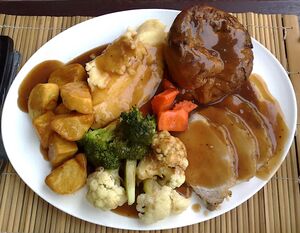
The traditional cuisine of Yorkshire, in common with the North of England in general, is known for using rich-tasting ingredients, especially with regard to sweet dishes, which were affordable for the majority of people.[153] There are several dishes which originated in Yorkshire or are heavily associated with it.[153] Yorkshire pudding, a savoury batter dish, is by far the best known of Yorkshire foods, and is eaten throughout England. It is commonly served with roast beef and vegetables to form part of the Sunday roast[153] but is traditionally served as a starter dish filled with onion gravy within Yorkshire.[154] Yorkshire pudding is the base for toad in the hole, a dish containing sausage.[155]
Other foods associated with the county include Yorkshire curd tart, a curd tart recipe with rosewater;[156] parkin, a sweet ginger cake which is different from standard ginger cakes in that it includes oatmeal and treacle;[157] and Wensleydale cheese, a cheese made with milk from Wensleydale and often eaten as an accompaniment to sweet foods.[158] The beverage ginger beer, flavoured with ginger, came from Yorkshire and has existed since the mid-18th century. Liquorice sweet was first created by George Dunhill from Pontefract, who in the 1760s thought to mix the liquorice plant with sugar.[159] Yorkshire and in particular the city of York played a prominent role in the confectionery industry, with chocolate factories owned by companies such as Rowntree's, Terry's and Thorntons inventing many of Britain's most popular sweets.[160][161] Another traditional Yorkshire food is pikelets, which are similar to crumpets but much thinner.[162] The Rhubarb Triangle is a location within Yorkshire which supplies most of the rhubarb to locals.
In recent years curries have become popular in the county, largely due to the immigration and successful integration of Asian families. There are many famous curry empires with their origins in Yorkshire, including the 850-seater Aakash restaurant in Cleckheaton, which has been described as "the world's largest curry house".[163]
Beer and brewing
Yorkshire has a number of breweries including Black Sheep, Copper Dragon, Cropton Brewery, John Smith's, Sam Smith's, Kelham Island Brewery, Theakstons, Timothy Taylor, Wharfedale Brewery, Harrogate Brewery and Leeds Brewery.[164][165] The beer style most associated with the county is bitter.[166] As elsewhere in the North of England, when served through a handpump, a sparkler is used giving a tighter, more solid head.[167]
Brewing has taken place on a large scale since at least the 12th century, for example at the now derelict Fountains Abbey which at its height produced 60 barrels of strong ale every ten days.[168] Most current Yorkshire breweries date from the Industrial Revolution of the late 18th and early 19th century.[164]
Music

Yorkshire has a heritage of folk music and folk dance including the Long Sword dance.[169] Yorkshire folk song was distinguished by the use of dialect, particularly in the West Riding and exemplified by the song 'On Ilkla Moor Baht 'at', probably written in the late 19th century, using a Kent folk tune (almost certainly borrowed via a Methodist hymnal),[بحاجة لمصدر] seen as an unofficial Yorkshire anthem.[170] Famous folk performers from the county include the Watersons from Hull, who began recording Yorkshire versions of folk songs from 1965;[171] Heather Wood (born 1945) of the Young Tradition; the short-lived electric folk group Mr Fox (1970–72), The Deighton Family; Julie Matthews; Kathryn Roberts; and Kate Rusby.[171] Yorkshire has a flourishing folk music culture, with over forty folk clubs and thirty annual folk music festivals.[172] The 1982 Eurovision Song Contest was held in the Harrogate International Centre. In 2007 the Yorkshire Garland Group was formed to make Yorkshire folk songs accessible online and in schools.[173]
In the field of classical music, Yorkshire has produced some major and minor composers, including Frederick Delius, George Dyson, Philip Wilby, Edward Bairstow, William Baines, Kenneth Leighton, Eric Fenby, Haydn Wood, Arthur Wood, Arnold Cooke, Gavin Bryars, John Casken, and in the area of TV, film and radio music, John Barry and Wally Stott. Opera North is based at the Grand Theatre, Leeds. Leeds is also home to the Leeds International Piano Competition. The Huddersfield Contemporary Music Festival takes place annually in November. Huddersfield Choral Society is one of the UK's most celebrated amateur choirs.[174] The National Centre for Early Music is located in York.
The county is home to successful brass bands such as Black Dyke, Brighouse & Rastrick, Carlton Main Frickley, Hammonds Saltaire, and Yorkshire Imperial.

During the 1970s David Bowie, himself of a father from Tadcaster in North Yorkshire,[175] hired three musicians from Hull: Mick Ronson, Trevor Bolder and Mick Woodmansey; together they recorded Ziggy Stardust and the Spiders from Mars, an album considered by a magazine article as one of a 100 greatest and most influential of all time.[176] In the following decade, Def Leppard, from Sheffield, achieved worldwide fame, particularly in America. Their 1983 album Pyromania and 1987 album Hysteria are among the most successful albums of all time.[بحاجة لمصدر] Yorkshire had a very strong post-punk scene which went on to achieve widespread acclaim and success, including: The Sisters of Mercy, The Cult, Vardis, Gang of Four, ABC, The Human League, New Model Army, Soft Cell, Chumbawamba, The Wedding Present and The Mission.[177] Pulp from Sheffield had a massive hit in "Common People" during 1995; the song focuses on working-class northern life.[178] In the 21st century, indie rock and post-punk revival bands from the area gained popularity, including the Kaiser Chiefs, The Cribs and the Arctic Monkeys, the last-named holding the record for the fastest-selling debut album in British music history with Whatever People Say I Am, That's What I'm Not.[179]
Influenced by the local post punk scene, but also by national and international extreme metal acts such as Celtic Frost, Candlemass, and Morbid Angel, Yorkshire-based bands Paradise Lost and My Dying Bride laid the foundations of what would become the Gothic Metal genre in the early to mid-1990s.[180][181]
Film and television productions
Among prominent British television shows filmed in (and based on) Yorkshire are the sitcom Last of the Summer Wine, the drama series Heartbeat, and the soap opera Emmerdale. Last of the Summer Wine in particular is noted for holding the record of longest-running comedy series in the world, from 1973 until 2010.[182] Other notable television series set in Yorkshire include Downton Abbey, All Creatures Great and Small, The Beiderbecke Trilogy, Rising Damp, Open All Hours, Band Of Gold, Dalziel and Pascoe, Fat Friends, The Syndicate, No Angels, Drifters and The Royal. During the first three series of the sitcom The New Statesman, Alan B'Stard represented as MP the fictional constituency of Haltenprice in North Yorkshire. Several noted films are set in Yorkshire, including Kes, This Sporting Life, Room at the Top, Brassed Off, Mischief Night, Rita, Sue and Bob Too, The Damned United, Four Lions, God's Own Country and Calendar Girls. The Full Monty, a comedy film set in Sheffield, won an Academy Award and was voted the second-best British film of all time by Asian News International.[183]
Yorkshire has remained a popular location for filming in more recent times.[184][185] For example, much of ITV's highly acclaimed Victoria was filmed in the region, at locations such as Harewood House in Leeds and Beverley Minster (with the latter being used to depict Westminster Abbey and St James’ Palace),[186][187] whilst Channel 5 has programmed numerous Yorkshire-themed documentary series such as Our Yorkshire Farm and The Yorkshire Steam Railway: All Aboard across its schedule.[188][189]
West Yorkshire has particularly benefited from a great deal of production activity.[190][191] For example, portions of the BBC television series Happy Valley and Last Tango in Halifax were filmed in the area, in Huddersfield and other cities; in addition to exteriors, some of the studio filming for Happy Valley was done at North Light Film Studios at Brookes Mill, Huddersfield. Although set in the fictional town of Denton, popular ITV detective series A Touch Of Frost was filmed in Yorkshire, mainly in and around Leeds. The BBC's Jamaica Inn and Remember Me and the ITV series Black Work were also filmed at the studios and in nearby West Yorkshire locations.[192][193][194][195] More recently, many of the exteriors of the BBC series Jericho were filmed at the nearby Rockingstone Quarry, and some interior work was done at North Light Film Studios.[196]
النقل

الثقافة
العمارة
الأداب والفنون
الرياضة

المطبخ

صناعة الجعة
الموسيقى والسينما
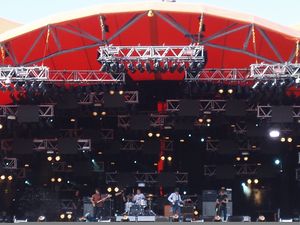
الحكومة
السياسة
الملكية والإمارة

مشاهير يوركشاير
انظر أيضاً
- موضوعات عن إنگلترة
- يوركشاير وهمبر
- زلزال دوگر بنك 1931
- East Riding of Yorkshire
- High Sheriff of Yorkshire
- List of collieries in Yorkshire 1984-present with dates of closure
- قائمة الكنائس التبشيرية في يوركشاير
- قائمة الجاليات اليهودية في يوركشاير
- Lord Lieutenant of Yorkshire
- شمال يوركشاير
- جنوب يوركشاير
- غرب يوركشاير
- خدمة إسعاف يوركشاير
- جمعية بناء يوركشاير
- Yorkshire Forward
- Yorkshire Regiment
- پودينگ يوركاشير
- مجتمع يوركاشير
- Yorkshire Terrier
- Yorkshire Wolds
- بنك يوركاشير
المصادر
- ^ أ ب ت ث ج ح "200 years of the Census in Yorkshire" (PDF). National Statistics. 2001. Archived (PDF) from the original on 25 June 2008. Retrieved 15 July 2008. Note that the area of Yorkshire increases slightly from 3,669,510 acres (14,850 km2) in 1831 to 3,883,979 acres (15,718 km2) in 1901 and then reduces to 2,941,246 acres (11,903 km2) in 1991, so that these three figures relate to different areas.
- ^ "Population Estimates for UK, England and Wales, Scotland and Northern Ireland, Mid-2019". Office for National Statistics. 6 May 2020. Retrieved 6 May 2020.
- ^ G. Gibbons, Yorkshire: Britain's Largest County (London: Geographica Ltd., 1969).
- ^ "Yorkshire Ridings Society". Retrieved 2009-06-03.
- ^ أ ب ت Allen, Liam (1 August 2006). "What's so special about Yorkshire?". BBC. Retrieved 2008-07-15.
- ^ "New Yorkshire Regiment is formed". BBC. 6 June 2006. Archived from the original on 25 June 2006. Retrieved 8 October 2008.
- ^ "Fall in love with our National Parks". Welcome to Yorkshire. 30 August 2016. Archived from the original on 23 January 2021. Retrieved 8 February 2021.
- ^ Rushby, Kevin (3 September 2013). "Yorkshire - God's own country is the best place in Europe". The Guardian. Retrieved 2 April 2018.
- ^ أ ب "God's own County". The Guardian. London. 2 June 2006. Archived from the original on 2 October 2013. Retrieved 24 October 2007.
- ^ "The Olympics are just what we need to bring Yorkshiremen together as a nation". The Telegraph. Archived from the original on 10 January 2022. Retrieved 20 April 2016.
- ^ "Yorkshire (United Kingdom)". CRWFlags.nom. Archived from the original on 14 October 2007. Retrieved 25 October 2007.
- ^ Wainwright, Martin (29 July 2008). "Proud Yorkshire can finally fly white rose flag without charge". The Guardian. London. Archived from the original on 4 January 2014. Retrieved 29 July 2008.
- ^ "Yorkshire Day". Army.mod.uk. 18 February 2008. Archived from the original on 14 January 2009. Retrieved 3 October 2008.
- ^ Mills, A.D. (2003). Oxford Dictionary of British Place Names. Oxford: Oxford University Press. ISBN 978-0-19-852758-9.
- ^ Harper, Douglas. "Shire". Online Etymology Dictionary. Archived from the original on 27 April 2014. Retrieved 27 April 2014.
- ^ "The Brigantes". Roman-Britain.co.uk. Archived from the original on 25 November 2021. Retrieved 25 November 2021.
- ^ Ptolemy, Geographia 2.1 Archived 6 مارس 2022 at the Wayback Machine, 2.2 Archived 6 مارس 2022 at the Wayback Machine
- ^ "The Parisii". Roman-Britain.co.uk. Archived from the original on 25 November 2021. Retrieved 25 November 2021.
- ^ "Romans in Britain". Romans-In-Britain.org.uk. Archived from the original on 17 October 2007. Retrieved 25 October 2007.
- ^ "Cartimandua". West Yorkshire Archaeology Advisory Service. 2007. Archived from the original on 9 October 2007. Retrieved 3 October 2008.
- ^ "The Brigantes". House Shadow Drake. Archived from the original on 21 October 2006. Retrieved 25 October 2007.
- ^ "Lower (Britannia Inferior) and Upper Britain (Britannia Superior)". VanderBilt.edu. Archived from the original on 2 March 2008. Retrieved 24 October 2007.
- ^ أ ب "Roman York – a brief introduction to York's Roman History". York Roman Festival. Archived from the original on 8 October 2007. Retrieved 25 October 2007.
{{cite web}}: CS1 maint: bot: original URL status unknown (link) - ^ "Roman York". Britain Express. Archived from the original on 14 October 2007. Retrieved 25 October 2007.
- ^ "Beowulf and other Viking ancestors". History of English podcast. Retrieved 4 July 2022.
{{cite web}}: CS1 maint: url-status (link) - ^ "Ebrauc". HistoryFiles.co.uk. Archived from the original on 30 September 2007. Retrieved 25 October 2007.
- ^ "Elmet". HistoryFiles.co.uk. Archived from the original on 1 October 2009. Retrieved 25 October 2007.
- ^ "What's in a Dales name?". Dales Discoveries. Retrieved 4 July 2022.
{{cite web}}: CS1 maint: url-status (link) - ^ "Settlers in Northumbria". Wilcuma. Retrieved 5 July 2022.
{{cite web}}: CS1 maint: url-status (link) - ^ "Were there Huns in Anglo-Saxon England? Some thoughts on Bede, Priscus & Attila". caitlyngreen.org. Retrieved 5 July 2022.
{{cite web}}: CS1 maint: url-status (link) - ^ "The Anglo-Saxons". BBC. Archived from the original on 17 October 2007. Retrieved 25 October 2007.
- ^ "What Happened to Them?". Jorvik-Viking-Centre.co.uk. Archived from the original on 12 October 2007. Retrieved 25 October 2007.
- ^ "The Viking Kingdom of York". Viking.no. 15 April 2000. Archived from the original on 25 December 2007. Retrieved 24 October 2007.
- ^ "Narrative History of York: Viking Times". Britannia.com. Archived from the original on 18 August 2017. Retrieved 25 October 2007.
- ^ أ ب "Part Two – Jorvik and the Viking Age (866 AD – 1066 AD)". NorthEastEngland.net. Archived from the original on 29 October 2007. Retrieved 25 October 2007.
- ^ "Eric Bloodaxe". HistoryFiles.co.uk. Archived from the original on 1 October 2009. Retrieved 25 October 2007.
- ^ "Narrative History of York: Late Saxon Times". Britannia.com. Archived from the original on 23 June 2008. Retrieved 25 October 2007.
- ^ "Resistance in the North East – 1069". The Norman Conquest School Site. Archived from the original on 26 October 2008. Retrieved 3 October 2008.
- ^ "Harrying of the North". The Norman Conquest School Site. Archived from the original on 24 October 2008. Retrieved 24 October 2007.
- ^ "Orderic's reaction". The Norman Conquest School Site. Archived from the original on 26 October 2008. Retrieved 24 October 2007.
- ^ أ ب ت "Yorkshire". LocalHistories.org. Archived from the original on 15 September 2007. Retrieved 24 October 2007.
- ^ "The Battle of the Standard". Britain Express. Archived from the original on 30 September 2007. Retrieved 25 October 2007.
- ^ أ ب "Middleham Castle". RichardIII.com. Archived from the original on 13 August 2007. Retrieved 24 October 2007. خطأ استشهاد: وسم
<ref>غير صالح؛ الاسم "middleham" معرف أكثر من مرة بمحتويات مختلفة. - ^ Gravett, Christopher (1999). Towton 1461: England's Bloodiest Battle. Osprey Publishing. ISBN 978-0-415-09378-1.[dead link]
- ^ "Yorkists". Stanford.edu. Retrieved 24 October 2007.[dead link]
- ^ Hey, David (2005). History of Yorkshire: County of the Broad Acres. Carnegie Publishing. ISBN 1-85936-122-6.
- ^ "St. Margaret Clitherow". Catholic Encyclopedia. Archived from the original on 11 October 2007. Retrieved 25 November 2007.
- ^ "Seeds of the English Civil War". BBC. Archived from the original on 25 July 2010. Retrieved 25 November 2007.
- ^ "Historic Cleveland – Timeline". Historic-Cleveland.co.uk. Archived from the original on 30 November 2007. Retrieved 25 November 2007.
- ^ "The York March and Marston Moor". British-Civil-Wars.co.uk. Archived from the original on 28 February 2009. Retrieved 25 November 2007.
- ^ "History of the NUM: 1 – Towards A National Union". NUM.org.uk. Archived from the original on 19 April 2008. Retrieved 25 November 2007.
- ^ "William Hirst – Leeds woollen industry pioneer". BBC. Archived from the original on 30 June 2008. Retrieved 25 November 2007.
- ^ "The Historical Society for Leeds and District". Thoresby.org.uk. Archived from the original on 29 December 2007. Retrieved 25 November 2007.
- ^ "National Railway Museum, York". NRM.org.uk. Archived from the original on 25 February 2011. Retrieved 25 November 2007.
- ^ Hampton, W., Local Government and Urban Politics, (1991)
- ^ "Harrogate, Yorkshire Spa town". Great-British.co.uk. Archived from the original on 13 October 2007. Retrieved 25 November 2007.
- ^ Halpenny, Bruce Barrymore (1982). Action Stations: Military Airfields of Yorkshire v. 4. PSL. ISBN 978-0-85059-532-1.
- ^ "Commission See Tees-Side As County Borough 12 Local Authorities into One". The Times. 21 November 1963. p. 8.
- ^ أ ب HMSO, Aspects of Britain: Local Government, (1996)
- ^ أ ب "Local Government Structure". Politics.co.uk. Archived from the original on 11 February 2007. Retrieved 25 November 2007.
- ^ Arnold-Baker, C., Local Government Act 1972, (1973)
- ^ Services, Web. "One Yorkshire devolution". City of York Council. Archived from the original on 14 August 2021. Retrieved 7 August 2021.
- ^ "Before we have Indyref 2, we need a vote on Yorkshire devolution". prospectmagazine. prospectmagazine. Archived from the original on 7 May 2021. Retrieved 7 August 2021.
- ^ "One Yorkshire". One Yorkshire. Archived from the original on 7 August 2021. Retrieved 7 August 2021.
- ^ أ ب ت "Yorkshire Geology". Genuki.org. Archived from the original on 18 October 2007. Retrieved 24 October 2007.
- ^ "The historic counties of England". JLCarr.info. Archived from the original on 8 February 2005. Retrieved 24 October 2007.
- ^ أ ب ت ث ج ح British Canoe Union, Yorkshire; Humberside Region, Access and Recreation Committees; prepared by Mike Twiggs & David Taylor (1992). Yorkshire Rivers: A Canoeists Guide. Menasha Ridge Press. ISBN 978-1-871890-16-7.
- ^ "Areas of Outstanding Natural Beauty". Natural England. Archived from the original on 23 December 2008. Retrieved 3 May 2008.
- ^ "Heritage Coasts". Natural England. Archived from the original on 25 June 2008. Retrieved 3 May 2008.
- ^ أ ب "Yorkshire and Humberside: the North East". BritainGallery. Archived from the original on 8 August 2007. Retrieved 24 October 2007.
- ^ "A Filey Walk". FileyBay.com. Archived from the original on 8 August 2008. Retrieved 24 October 2007.
- ^ "North Yorkshire Heritage Coast". Britain Express. Archived from the original on 7 August 2007. Retrieved 24 October 2007.
- ^ "Moor House-Upper Teesdale NNR". Natural England. Archived from the original on 3 October 2009. Retrieved 16 July 2009.
- ^ "15 Waterfalls to Visit in the UK". Go Outdoors. Archived from the original on 12 June 2020. Retrieved 12 June 2020.
- ^ "15 Mickle Fell". hill-bagging.co.uk. Archived from the original on 12 June 2020. Retrieved 12 June 2020.
- ^ Herriot, James (1979). James Herriot's Yorkshire. St. Martin's Press. ISBN 0-312-43970-9.
- ^ "About Bempton Cliffs". RSPB.org.uk. Archived from the original on 20 November 2007. Retrieved 24 October 2007.
- ^ "A cyclic coastal landform". Spurn Point. Archived from the original on 17 October 2007. Retrieved 24 October 2007.
- ^ "In pictures: Scarborough". BBC. 20 August 2006. Archived from the original on 1 February 2009. Retrieved 24 October 2007.
- ^ "Report rates the best UK beaches". BBC. 9 May 2006. Archived from the original on 1 February 2009. Retrieved 24 October 2007.
- ^ أ ب Settlements as defined as built-up area sub divisions from قالب:NOMIS2011
- ^ Beckett, John (2017). City Status in the British Isles, 1830–2002. Taylor and Francis. p. 12. ISBN 978-1351951265. Archived from the original on 15 August 2021. Retrieved 27 September 2020.
- ^ "No. 46255". The London Gazette. 4 April 1974. p. 4401.
- ^ "No. 54363". The London Gazette. 4 April 1996. p. 4925.
- ^ Beckett, John (2017). City Status in the British Isles, 1830–2002. Taylor and Francis. pp. 24–28. ISBN 978-1351951265. Archived from the original on 15 August 2021. Retrieved 27 September 2020.
- ^ Beckett, John (2017). City Status in the British Isles, 1830–2002. Taylor and Francis. p. 39. ISBN 978-1351951265. Archived from the original on 15 August 2021. Retrieved 27 September 2020.
- ^ "History of the Secular and Diocesan Boundaries in Yorkshire" (PDF). Church of England. p. 30. Archived from the original (PDF) on 2 February 2014.
- ^ "No. 25837". The London Gazette. 13 July 1888. p. 3826.
- ^ "Kingston upon Hull UA/City: Total Population". A Vision of Britain Through Time. Great Britain Historical GIS Project. Archived from the original on 13 June 2020. Retrieved 13 June 2020.
- ^ Cook, Chris; Stevenson, John (1988). The Longman Handbook of Modern British History 1714–1987 (2ndd ed.). Longman. p. 114. ISBN 0-582-01329-1.
- ^ "No. 26947". The London Gazette. 14 March 1898. p. 1689.
- ^ "No. 26374". The London Gazette. 21 February 1893. p. 944.
- ^ أ ب "No. 46255". The London Gazette. 4 April 1974. p. 4400.
- ^ "Platinum Jubilee: Eight towns to be made cities for Platinum Jubilee". BBC News. 20 May 2022. Retrieved 20 May 2022.
- ^ Hinson, Colin (2011). "GENUKI: Yorkshire Genealogy". genuki.org.uk. Archived from the original on 29 June 2011. Retrieved 29 June 2011.
- ^ "LGBCE – Yorkshire and the Humber". lgbce.org.uk. 2011. Archived from the original on 3 June 2011. Retrieved 29 June 2011.
- ^ "BBC – Bradford and West Yorkshire – A Sense of Place – Coal mining in West Yorkshire: The end of an era". Archived from the original on 10 April 2011. Retrieved 16 November 2011.
- ^ "Watching the pits disappear". BBC News. London. 5 March 2004. Archived from the original on 16 February 2009. Retrieved 16 November 2011.
- ^ "Jobs safeguarded as coal pit sold". BBC News. London. 27 February 2007. Archived from the original on 3 March 2007. Retrieved 16 November 2011.
- ^ "Miners march to mark closure of Maltby Colliery". BBC News. 6 April 2013. Retrieved 13 June 2022.
- ^ "York Marketing Strategy 13 August 2020" (PDF). Archived from the original (PDF) on 20 October 2020. Retrieved 2 March 2021.
- ^ "WE'VE BEEN EVOLVING FOR ALMOST TWO HUNDRED YEARS". Convention Centre. Archived from the original on 28 February 2021. Retrieved 1 March 2021.
- ^ "Our Locations". www.pdports.co.uk. Archived from the original on 20 November 2012. Retrieved 5 January 2013.
- ^ "Region: North East – Trunk Road A1 in the North Riding of Yorkshire". The Motorway Archive. Archived from the original on 17 October 2007. Retrieved 24 October 2007.
- ^ Marshall, Chris; Jones, Clive; Chris "c2R"; Mohan, John; Carty, George (2008). "Motorway Database". CBRD. Archived from the original on 11 May 2008. Retrieved 24 April 2008.
{{cite web}}: CS1 maint: numeric names: authors list (link) - ^ "M62 Liverpool to Hull". Government of the United Kingdom. Archived from the original on 21 November 2008. Retrieved 24 October 2007.
- ^ Marshall, Chris (2008). "Motorway Database". CBRD. Archived from the original on 19 July 2017. Retrieved 24 April 2008.
- ^ "East Coast Mainline Upgrade Could Create 2000 New Jobs". Yorkshire Forward. Archived from the original on 11 November 2006. Retrieved 24 October 2007.
- ^ "Hull Ferry Port Information". BoozeCruise.com. Archived from the original on 19 August 2007. Retrieved 24 October 2007.
{{cite web}}: CS1 maint: bot: original URL status unknown (link) - ^ "Leeds Bradford International Airport". Airports-Worldwide.com. Archived from the original on 14 November 2007. Retrieved 24 October 2007.
- ^ "History of the Airport". RobinHoodAirport.com. Archived from the original on 23 July 2007. Retrieved 24 October 2007.
- ^ "Yorkshire Public Transportation Statistics". Global Public Transit Index by Moovit. Archived from the original on 1 September 2017. Retrieved 19 June 2017.
 Material was copied from this source, which is available under a Creative Commons Attribution 4.0 International License Archived 16 أكتوبر 2017 at the Wayback Machine.
Material was copied from this source, which is available under a Creative Commons Attribution 4.0 International License Archived 16 أكتوبر 2017 at the Wayback Machine.
- ^ "Castles in Yorkshire". Britain Express. Archived from the original on 16 October 2007. Retrieved 24 October 2007.
- ^ أ ب ت "About Yorkshire". English Heritage. Archived from the original on 3 February 2010. Retrieved 24 October 2007.
- ^ "Northside, August 2006" (PDF). NorthernLifestyle.com. Archived from the original (PDF) on 27 May 2008. Retrieved 24 October 2007.
Saumarez Smith, Charles (1990). The Building of Castle Howard. University of Chicago Press. ISBN 0-226-76403-6. Archived from the original on 17 August 2021. Retrieved 23 November 2020.
"Castle Howard". Britain Express. Archived from the original on 16 October 2007. Retrieved 24 October 2007. - ^ "Welcome to The Treasure Houses of England". TreasureHouses.co.uk. Archived from the original on 18 October 2007. Retrieved 24 October 2007.
- ^ "Yorkshire & the North East". National Trust. Archived from the original on 22 October 2007. Retrieved 24 October 2007.
- ^ "The Piece Hall – Halifax". Archived from the original on 21 October 2014. Retrieved 13 October 2014.
- ^ أ ب ت "Yorkshire Abbeys – Yorkshire Minsters – Yorkshire Cathedrals". Dalesman.co.uk. Archived from the original on 31 August 2007. Retrieved 24 October 2007.
- ^ Snyder, Christopher A. (2003). "Northern Britons". The Britons. pp. 198–224. doi:10.1002/9780470758366.ch10. ISBN 9780470758366.
- ^ "Earl of Richmond". Everything.com. Archived from the original on 6 March 2022. Retrieved 24 October 2007.
- ^ "He's a shrewd, straight-talking Yorkshireman – not English, mind you, Yorkshire". Conservatives.com. Archived from the original on 17 June 2007. Retrieved 7 May 2015.
- ^ Keane, Peter. "Tyke: It's all the Vikings' fault (sort of)". BBC Bradford and West Yorkshire. BBC. Archived from the original on 27 March 2017. Retrieved 14 February 2017.
- ^ "North Yorkshire > Voices > Glossary". BBC News. 2015. Archived from the original on 31 January 2017. Retrieved 14 February 2017.
- ^ "Technology and gender". The British Library. Archived from the original on 20 September 2021. Retrieved 2 March 2021.
- ^ "Yorkshire dialect: Miss Dibnah explains the different methods for baking white bread, brown bread and spice bread". The British Library. Archived from the original on 9 December 2020. Retrieved 2 March 2021.
- ^ أ ب "Yorkshire dialect – an explanation". Archived from the original on 9 July 2021. Retrieved 2 March 2021.
- ^ Kellett, Arnold (January 1994). The Yorkshire Dictionary of Dialect, Tradition and Folklore. Smith Settle. ISBN 1-85825-016-1.
- ^ Castelow, Ellen (21 April 2016). "Yorkshire Dialect". Historic UK. Historic UK. Archived from the original on 15 February 2017. Retrieved 14 February 2017.
Nah then,'ow do? – Nobbut middlin'.
- ^ "The National Anthem of Yorkshire 'God's own county'". DKSnakes.co.uk. Archived from the original on 12 September 2007. Retrieved 24 October 2007.
- ^ Moorman, F. W. (1914). "English Place Names and the Teutonic Sagas". In Elton, Oliver (ed.). English Association Essays and Studies. Vol. 5. Oxford: Clarendon. p. 75f.
- ^ "Whitby Abbey". Whitby-Abbey.co.uk. Archived from the original on 31 October 2007. Retrieved 25 October 2007.
- ^ أ ب "Biography of Family". BronteFamily.org. Archived from the original on 28 December 2007. Retrieved 25 October 2007.
- ^ "A brief history of English literature". UniversalTeacher.org.uk. Archived from the original on 15 March 2015. Retrieved 25 October 2007.
- ^ "Bronte Parsonage events and listings". digyorkshire.com. Archived from the original on 28 February 2010. Retrieved 18 June 2009.
- ^ "Bram Stoker and Whitby". Dracula-in-Whitby.com. Archived from the original on 28 October 2007. Retrieved 25 October 2007.
- ^ "Coast: Point 6 – Stoker". BBC. Archived from the original on 3 February 2009. Retrieved 25 October 2007.
- ^ "J. B. Priestley". Spartacus.schoolnet.co.uk. Archived from the original on 14 May 2011. Retrieved 25 October 2007.
- ^ أ ب ت Wainwright, Martin (19 October 2005). "The 50 greatest Yorkshire people?". The Guardian. London. Archived from the original on 27 August 2007. Retrieved 25 October 2007.
- ^ "Barbara Taylor-Bradford: The best-selling author on the latest in the Ravenscar saga". The Book Show. Archived from the original on 15 November 2007. Retrieved 25 October 2007.
- ^ "Thirsk Tourist Information". Hello Yorkshire. Archived from the original on 28 November 2009. Retrieved 8 June 2009.
- ^ Tabor, Mary B. W. (24 February 1995). "James Herriot, 78, writer, Dies; Animal Stories Charmed People". The New York Times. Archived from the original on 6 March 2022. Retrieved 6 April 2010.
- ^ "The Life of Andrew Marvell (1621–1678)". Luminarium.org. Archived from the original on 4 September 2006. Retrieved 25 October 2007.
- ^ "Poets' Corner – Andrew Marvell – Selected Works IV". TheOtherPages.org. Archived from the original on 12 December 2007. Retrieved 25 October 2007.
- ^ "Simon Armitage Biography". Archived from the original on 13 January 2013. Retrieved 5 November 2012.
- ^ "The Poetry of David Miedzianik". Archived from the original on 10 October 2006. Retrieved 7 October 2019.
- ^ "Visiting Yorkshire Sculpture Park – Bretton Hall". Haworth-Village.org.uk. Archived from the original on 13 October 2007. Retrieved 25 October 2007.
- ^ "Yorkshire Art Galleries". My-Yorkshire.co.uk. Archived from the original on 16 July 2011. Retrieved 25 October 2007.
- ^ "List of art galleries in Yorkshire". digyorkshire.com. Archived from the original on 5 August 2016. Retrieved 18 June 2009.
- ^ "Yorkshire Art Gallery and Galleries". RedRagGallery.co.uk. Archived from the original on 12 October 2007. Retrieved 25 October 2007.
- ^ "David Hockney". Artchive.com. Archived from the original on 20 October 2007. Retrieved 25 October 2007.
- ^ "1853 Gallery". Visit Bradford. Archived from the original on 17 July 2011. Retrieved 28 May 2008.
- ^ أ ب ت Favourite Yorkshire Recipes. Amanda Persey. قالب:ASIN.
- ^ "The Ultimate Yorkshire Pudding recipe". inpursuitofperfection. Archived from the original on 23 February 2014. Retrieved 7 August 2012.
- ^ "Individual Toad in the Hole Recipe". about.com. Archived from the original on 18 November 2012. Retrieved 7 August 2012.
- ^ "Yorkshire curd tart". BBC. Archived from the original on 31 December 2014. Retrieved 16 November 2014.
- ^ "Right good food from the Ridings". AboutFood.com. Archived from the original on 7 June 2007. Retrieved 25 October 2007.
- ^ "Yorkshire Recipes: Ginger Beer". Wensleydale.org. Archived from the original on 9 October 2007. Retrieved 25 October 2007.
- ^ "Liquorice in Pontefract" (PDF). Wakefield Council. Archived (PDF) from the original on 5 December 2014. Retrieved 27 November 2014.
- ^ "Safeguard for chocolate heritage". Yorkshire Post. 20 September 2007. Retrieved 25 October 2007.
- ^ "Chocolate is to York what mustard is to Norwich". VisitYork.org. Archived from the original on 31 January 2008. Retrieved 25 October 2007.
- ^ "Yorkshire Pikelets". Seymour-Recipes.com. Archived from the original on 12 January 2009. Retrieved 25 October 2007.
- ^ Roberts, John (20 October 2006). "New owner for world's largest curry house". Yorkshire Post. Retrieved 22 March 2009.
- ^ أ ب "Breweries in the Historic County of Yorkshire". quaffale.org.uk. Archived from the original on 23 November 2008. Retrieved 3 May 2009.
- ^ "About Leeds Brewery". leedsbrewery.co.uk. Archived from the original on 23 July 2012. Retrieved 7 August 2012.
- ^ "Yorkshire Beer Guide – Sally Howard freelance writer". sallyhoward.net. Archived from the original on 24 July 2011. Retrieved 3 May 2009.
- ^ "Roosters brewery – Frequently asked questions". roosters.co.uk. Archived from the original on 12 June 2008. Retrieved 3 May 2009.
- ^ "beer, by holy orders – St Albans Ale". Beer-pages.com. Archived from the original on 16 July 2011. Retrieved 5 August 2011.
- ^ Sharp, C. J. (2003). Sword Dances of Northern England Together with the Horn Dance of Abbots Bromley. Kessinger Publishing.
- ^ Kellett, A. (1988). On Ilkla Mooar baht 'at: the Story of the Song. Smith Settle.
- ^ أ ب Nidel, R. (2005). World Music: The Basics. London: Routledge. p. 90.
- ^ "Yorkshire based Artists and Groups". Folk and Roots'. Archived from the original on 9 February 2013. Retrieved 15 December 2012.
- ^ "Folk songs of traditional Yorkshire to be celebrated on group's heritage website". Yorkshire Post. 1 September 2007. Archived from the original on 2 April 2015. Retrieved 12 February 2009.
- ^ "Huddersfield Choral Society". Yorkshire Awards. Archived from the original on 19 April 2021. Retrieved 2 January 2021.
- ^ "Episode for 29 November 2003". Parkinson.
- ^ "The All-TIME 100 Albums". Time. 2 November 2006. Archived from the original on 1 December 2006. Retrieved 25 October 2007.
- ^ "Will the gods come from Leeds?". BBC. Archived from the original on 3 May 2005. Retrieved 25 October 2007.
- ^ "Common People". BBC. Archived from the original on 11 September 2007. Retrieved 25 October 2007.
- ^ "Arctic Monkeys win Mercury Prize". BBC News. 5 September 2006. Archived from the original on 6 September 2007. Retrieved 25 October 2007.
- ^ "Grim Northern Misery: How Paradise Lost and My Dying Bride took British gothic metal mainstream". 23 December 2020. Archived from the original on 26 January 2021. Retrieved 2 March 2021.
- ^ "OVER THE MADNESS (2007) – A DIRAN NOUBAR FILM". Archived from the original on 28 October 2021 – via www.youtube.com.
- ^ "Summer Wine – The Story". Summer-Wine.com. Archived from the original on 1 May 2008. Retrieved 3 October 2008.
- ^ "Monty Python's 'Life of Brian' tops Best British Movie list". Yahoo!. Archived from the original on 5 January 2008. Retrieved 25 October 2007.
- ^ "Yorkshire on Film and TV". Yorkshire Net. Yorkshire Net. 2016. Archived from the original on 8 February 2017. Retrieved 10 February 2017.
- ^ Daniels, Nia (2 October 2016). "Yorkshire wins funding to grow film hub". The Knowledge Online. Media Business Insight Limited. Archived from the original on 11 February 2017. Retrieved 10 February 2017.
Yorkshire has been announced by the BFI as the winner of National Lottery funding, aimed at encouraging emerging screen sector hubs
- ^ Travis, Ben (28 August 2016). "Victoria, ITV: cast, locations, and four other things you need to know about the period drama". London Evening Standard. Archived from the original on 11 February 2017. Retrieved 10 February 2017.
It was mostly filmed in Yorkshire. Recreating the opulence of royalty was achieved by a mix of locations and studio shoots.
- ^ Jacobs, Sherelle (6 October 2016). "Victoria: filming locations in Yorkshire and where to stay". The Daily Telegraph. London. Archived from the original on 10 January 2022. Retrieved 10 February 2017.
- ^ "Yorkshire, Yorkshire, everywhere! How Channel 5 scored lockdown viewing gold". The Guardian. 1 October 2020. Archived from the original on 21 October 2021. Retrieved 2 October 2020.
- ^ "The Yorkshire Steam Railway: All Aboard: Season 3". North York Moors Historical Railway Trust – NYMR. Archived from the original on 16 December 2021. Retrieved 2 October 2020.
- ^ "Productions at North Light Film Studios". North Light Film Studios. North Light Film Studios. 2017. Archived from the original on 11 February 2017. Retrieved 10 February 2017.
- ^ "Film & TV". Examiner. Huddersfield. 29 October 2016. Archived from the original on 14 November 2016. Retrieved 10 February 2017.
- ^ Ballinger, Lauren (5 December 2014). "North Light Film Studios – Remember Me filming locations". Examiner. Huddersfield. Archived from the original on 11 February 2017. Retrieved 10 February 2017.
- ^ Rees, Caroline (3 November 2013). "Sally Wainwright: not the same old". The Guardian. Archived from the original on 3 February 2014. Retrieved 19 January 2014.
- ^ Bremner, Jade (11 December 2013). "Last Tango in Halifax actress Sarah Lancashire begins shooting new crime drama in Yorkshire". Radio Times. Archived from the original on 9 February 2014. Retrieved 19 January 2014.
- ^ "Creative England provides filming location and crew support to new BBC drama Happy Valley when filming in Yorkshire". Creative England. 29 April 2014. Archived from the original on 30 May 2014. Retrieved 12 June 2014.
- ^ Gildea, Samantha (1 February 2016). "Jericho filming locations". Examiner. Huddersfield. Archived from the original on 16 November 2016. Retrieved 10 February 2017.
الهوامش
- a Though the Wars of the Roses were fought between royal houses bearing the names of York and Lancaster, the wars took place over a wide area of England. They were a dynastic clash between cadet branches of the House of Plantagenet.The most prominent family in Yorkshire, below the monarchy, the Nevilles of Sheriff Hutton and Middleham fought for the Yorkists, as did the Scropes of Bolton, the Latimers of Danby and Snape, as well as the Mowbrays of Thirsk and Burton in Lonsdale. Yet some fought for the Lancastrians such as the Percies, the Cliffords of Skipton, Ros of Helmsley, Greystock of Henderskelfe, Stafford of Holderness and Talbot of Sheffield.
وصلات خارجية
- تاريخ يوركشاير
- Samples of Yorkshire Dialect
- Yorkshire Inquisitions 1275-1295
- Yorkshire: historical and genealogical information at GENUKI
- Welcome to Yorkshire
- CS1 maint: bot: original URL status unknown
- CS1 maint: url-status
- Articles with dead external links from September 2021
- Articles with dead external links from July 2018
- CS1: Julian–Gregorian uncertainty
- CS1 maint: numeric names: authors list
- Pages using gadget WikiMiniAtlas
- Short description is different from Wikidata
- Articles with hatnote templates targeting a nonexistent page
- Missing redirects
- مقالات بلدان سابقة بحاجة إلى صيانة
- مقالات سابقة بحاجة إلى صيانة
- Pages using multiple image with auto scaled images
- مقالات المعرفة بحاجة للتحديث from May 2020
- كل مقالات المعرفة بحاجة لتحديث
- جميع الصفحات التي تحتاج تنظيف
- مقالات بالمعرفة تحتاج توضيح from December 2020
- Articles with unsourced statements from July 2015
- Coordinates on Wikidata
- يوركشاير
- مقاطعات إنگليزية تأسست في العصور القديمة
- Counties of England established in antiquity
- Counties of England disestablished in 1974

